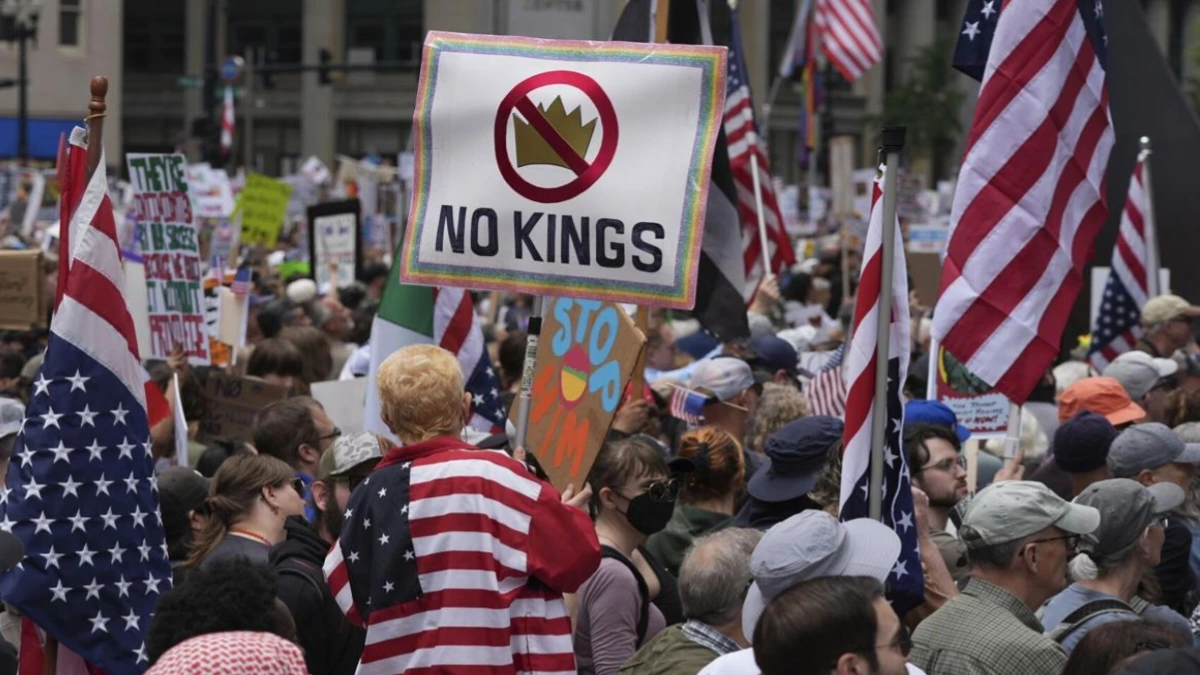Millions of Americans gathered across the United States on Saturday in what organizers described as one of the largest coordinated demonstrations of the year, protesting what they view as former President Donald Trump’s growing “authoritarian” influence.
The nationwide “No Kings” rallies drew nearly seven million participants in more than 2,700 locations, from major cities to small towns, according to event organizers.
“We’re standing up for democracy,” said Peggy Cole, a retired government worker from Flint, Michigan, who drove nearly ten hours to attend the main rally in Washington, DC “It feels like our government is being taken apart piece by piece, and if we don’t act now, it might be too late.”
The “No Kings” movement emerged earlier this year as a decentralized, citizen led campaign aimed at opposing what its members call Trump’s “anti democratic” agenda.
The protests follow a turbulent summer of immigration raids, legal battles over federal enforcement powers, and debate over the role of executive authority in American governance.
Saturday’s demonstrations marked the second wave of nationwide protests after a June series that drew about five million people.
Organizers said the October rallies surpassed those numbers, underscoring what they see as mounting public anxiety over Trump’s political resurgence and ongoing influence within the Republican Party.
While the rallies were largely peaceful, isolated confrontations occurred. Police in South Carolina arrested a woman accused of brandishing a firearm near a protest site, and in Georgia, a man was detained after shoving a demonstrator and tearing down a protest flag.
Authorities in major cities including New York, Los Angeles, and Chicago reported no major incidents and praised the crowd’s cooperation.
“These were peaceful gatherings, well coordinated and orderly,” said New York Police Department spokesperson Lt. Andrew McCarthy. “The message was clear, but the method was responsible.”
Political analysts said the “No Kings” protests reflected deeper public unease over the balance of power between the executive branch and democratic institutions.
Dr. Lena Hartwell, a political science professor at Georgetown University, said the rallies signaled “a broader societal reckoning with the question of how resilient democracy remains when it is challenged from within.”
“Regardless of one’s political views, this is a sign that millions of Americans are engaging with questions of accountability, transparency, and the limits of presidential authority,” Hartwell said. “It’s a historic display of civic participation.”
Conservative scholars, however, argued that labeling Trump’s leadership as “authoritarian” oversimplifies complex political dynamics.
“We should be cautious about overstating the threat,” said Jonathan Meyers, a fellow at the Liberty Policy Institute. “Dissent is essential, but framing political disagreement as tyranny risks deepening polarization.”
According to the Indivisible Project, the nonprofit organizing the rallies, attendance figures nearly matched participation levels in the 2017 Women’s March.
More than 100,000 people gathered in New York City alone, while thousands filled public squares in Los Angeles, Chicago, Atlanta, and Denver. Smaller towns, from Des Moines to Boise, saw local groups line highways with banners and yellow flags a symbol of unity adopted by organizers.
“Yellow represents light and courage,” the movement’s website reads. “It’s a color of hope, a reminder that America belongs to its people, not to kings.”
Independent researchers at CrowdCount, a civic data firm, estimated total participation between 6.2 million and 6.9 million making “No Kings” one of the largest grassroots demonstrations in recent US history.
In Atlanta, Democratic Sen. Raphael Warnock addressed a crowd of thousands, invoking the city’s legacy in the civil rights movement. “This is not about the people in power,” Warnock said. “It’s about the power in the people.”
Kimberly Diemert, communications director for the Georgia chapter of 50501 a partner movement supporting the protests said the gatherings were designed to remind Americans that “freedom and justice require constant vigilance.”
In Los Angeles, protesters carried American flags, handmade signs, and even inflatable costumes. “It’s a party for democracy,” said 29 year old teacher Miguel Alvarez, dressed in a frog costume. “It’s hard to call us radicals when we’re out here dancing to music and waving flags.”
Others emphasized personal milestones. “I turned seventy this week,” said Cole, the Flint resident. “I wanted to spend my birthday standing for something that matters.”
In New York, longtime activist Marjorie Fields carried a sign reading, “We protest because we love America, and we want it back.”
She told reporters she had marched since the 1960s but felt the stakes were higher now. “This time feels different. It feels like we’re fighting for the system itself,” Fields said.
Organizers said they plan to continue monthly demonstrations leading up to the 2026 midterm elections. “Our focus now is on voter education, civic engagement, and local organizing,” said Indivisible Project director Tamika Rhodes.
The message is simple democracy is a shared responsibility. Law enforcement agencies nationwide said they expect more such gatherings but do not anticipate significant unrest if coordination remains peaceful.
“What we’re seeing is the exercise of First Amendment rights on a massive scale,” Lt. McCarthy said. “That’s something to be managed, not feared.”
As the sun set over Washington, thousands of yellow flags waved in front of the Capitol. Protesters chanted, “This is what democracy looks like,” echoing a message that resonated from coast to coast.
Whether the “No Kings” movement endures beyond its symbolic rallies remains to be seen. But for millions of Americans who turned out this weekend, the message was clear their fight, they said, is not against a man, but for the idea of democracy itself.

